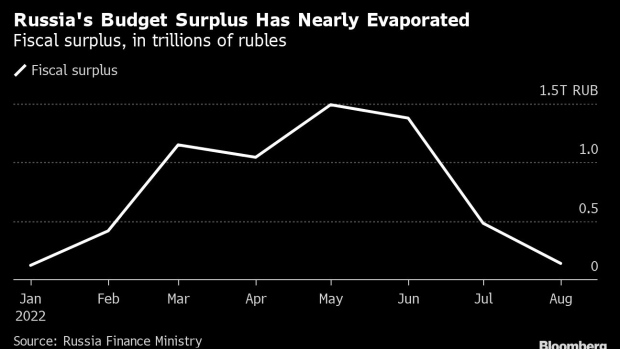Sep 23, 2022
Putin Readies 43% Defense Spending Hike Amid Plan for Longer War
, Bloomberg News

(Bloomberg) -- President Vladimir Putin is looking to spend far more on the military in the next two years than initially planned as Russia tailors the budget to the needs of a longer and increasingly costly war in Ukraine.
Defense expenditure is now set to exceed next year’s initial budget assumptions by more than 43%, while the related category of national security and law enforcement will go up by over 40%, according to a three-year fiscal plan seen by Bloomberg.
Fiscal projections are in flux as priorities become skewed in favor of the military and away from areas like environmental protection. At almost 5 trillion rubles ($84 billion), or 3.3% of gross domestic product, outlays on “national defense” are now second to the government’s social programs as a share of spending.
The Stockholm International Peace Research Institute, or SIPRI, estimates the “national defense” line in Russia’s budget accounts for about three-quarters of its total military expenditure and counts funding on operational costs as well as arms procurement.
By contrast, the allocation of money on education and culture is barely increasing for 2023, according to the document. Expenditure on the environment will be about a quarter less than first budgeted at 0.2% of GDP. The initial plan called for defense spending next year to fall to 2.4% of economic output, from an estimated 3.2% in 2022 and 2.6% the year before.
The shift reflects a greater commitment to a war that’s already come at enormous cost in blood and treasure to Ukraine and Russia. Major setbacks on the battlefield saw Putin escalate his efforts to regain some momentum this week, when he announced a “partial mobilization” to draft as many as 300,000 reservists.
The budget plan puts the cost of the call-up at almost 16 billion rubles in 2023 and 16.5 billion rubles annually in 2024-2025. Most other details of military spending remain classified and only overall figures are made public.
Russia was among the world’s five biggest defense spenders last year, according to SIPRI, which tracks the global arms industry. The think-tank estimates the Kremlin boosted expenditure on the military by 2.9% in 2021 to $65.9 billion, the third straight year of growth following declines between 2016 and 2019.
What Bloomberg Economics Says...
“The mobilization’s first round impact will be a one-off hit to output that will deepen this year’s contraction to -3.75%, based on our calculations. The main channel is a reduced labor force, as the announcement will likely trigger a wave of workforce brain-drain to safe heavens in neighboring countries and beyond -- a repeat of events in February.”
--Alexander Isakov, Russia economist. For more, click here
The government on Thursday approved the budget plan, and the bill must now win the backing of both houses of parliament and be signed by the president to become law. It’s still subject to change but most assumptions are unlikely to see major revisions.
Under the latest projections, the budget deficit will widen next year to 2% of GDP from 0.9% in 2022. The government will mostly finance the shortfall with debt and from reserves. The plan also envisions borrowing up to $1 billion annually in foreign currencies.
Russia defaulted on its external sovereign bonds in late June, the result of international sanctions that blocked payment channels to overseas creditors since the invasion of Ukraine in February.
Financial Strain
The diversion of resources and manpower to the military will be a drain on an economy in recession, its labor market already stretched by poor demographics and with unemployment at an all-time low.
It also threatens to become a strain on public finances, especially as a standoff intensifies over Russia’s supply of energy to Europe. Annual pipeline gas exports are set to drop by almost 40% in 2023-2025, according to the budget plan, with crude shipments increasing slightly.
The government’s balance sheet has held up well through the crisis, thanks in part to windfall earnings from the higher cost of commodities.
Still, drawdowns from the sovereign wealth fund mean it will contract by just over 3 trillion rubles in two years. The government will also need to compensate the higher expenses with rising taxes.
Fiscal projections beyond next year suggest Russia is nowhere near drawing up plans to move away from a war footing. Relative to earlier projections, defense expenditure will go up by almost 30% in 2024 but is still in line with previous assumptions for 2025.
Among other changes, the budget will also allocate more money for “patriotic education,” a program that includes history exhibits, and factors in spending increases to equip schools with state symbols.
©2022 Bloomberg L.P.







